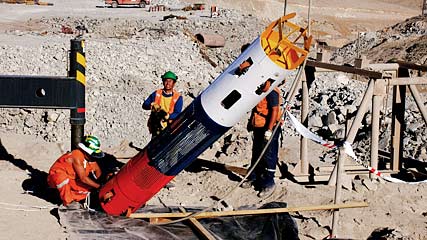
© AP/Chile's PresidencyNASA's Fenix Capsule
For 69 days, 33 miners were trapped in the San Jose copper and gold mine in Chile after a rockslide closed off their exit. But now, with the
help of an escape capsule designed by NASA, the miners are being carried back to the Chilean surface to be reunited with family as well as seek medical attention.
The miners have been trapped 2,300 feet below ground level since August 5. They were discovered 17 days after the rockslide, and
have survived until now due to rescue workers lowering water, food, medicine and other supplies down to the men.
Around this same time in late August,
NASA dispatched a four-man team to the mine. The team consisted of Clinton Cragg, a NASA engineer; Michael Duncan, a doctor; James Polk, a doctor, and Al Holland, a psychologist.
Cragg began designing an escape capsule that could fit in a hole the size of a bicycle tire, and handed the finished plans to the Chilean navy, who built the capsule. The finished product was a 13-foot long, 924 pound steel rescue craft that had an escape hatch at the bottom. It was named "Fenix," after the mythical bird that rose from ashes. The Fenix capsule is very narrow, where miners have
barely any room to move their shoulders, but contains a safety harness, a device to communicate with rescue teams and a clock.